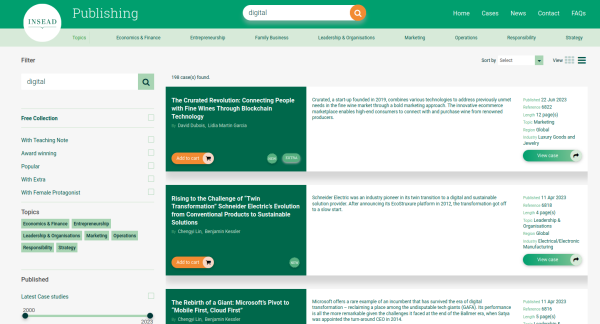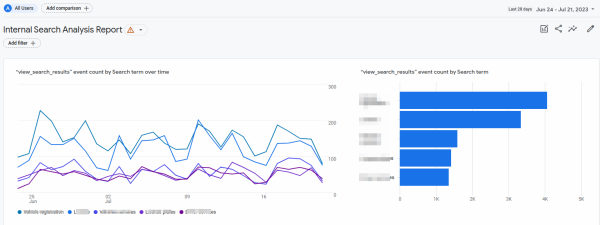Internal Site Search Analytics: Transforming Data into Actionable Decisions
Introduction
In the realm of digital transformation, data has emerged as the lifeblood of organizations, holding the potential to unlock valuable insights and drive strategic decision-making. Every interaction a visitor has on your website, including their internal site search, presents an opportunity to gain helpful information.
Incorporating website analytics tools such as Google Analytics enables tracking a visitor's interactions on a website. Beyond monitoring page views and other default events, one particularly promising area lies in on-site or internal site search. By analyzing how visitors engage with internal site searches, valuable insights can be gleaned, empowering digital transformation initiatives.
In this article, we will explore the advantages of tracking internal site search, its impact on enhancing the user experience and the key performance indicators (KPIs) organizations should monitor.
The Untapped Potential of Internal Site Search Data

Internal search data contains a wealth of information that is often underutilized. The keywords and phrases visitors input into the search bar provide valuable insights into their interests, needs, and pain points. By analyzing this data, organizations gain a deeper understanding of customer preferences and behaviours, fueling data-driven decision-making and digital transformation.
Advantages of Tracking Internal Site Search
Understanding User Behavior: Uncovering User Intent
Tracking internal searches enables organizations to comprehend user behaviour better. The keywords used in search queries reveal the topics visitors are actively seeking. By analyzing this data, content creators can align their content with user intent, ensuring that articles, blogs, and resources resonate with their audience.
Refining Content Strategies: Addressing Content Gaps
Internal search data helps identify content gaps on a general content site. Organizations can pinpoint areas lacking relevant information by analyzing keywords that yield no results. With this knowledge, content teams can fine-tune their content strategies to ensure user queries are met with valuable and engaging content.
Enhancing User Experience: Optimizing Navigation
Monitoring popular keyword usage sheds light on user interests and frequently searched topics. This insight guides improvements in the website's navigation system, making accessing content related to popular keywords easier. An optimized navigation system enhances user experience, increasing engagement and longer website sessions.
Personalizing User Interactions: Delivering Tailored Content
By analyzing internal search data, organizations can personalize user interactions. Understanding what users seek allows for targeted content recommendations and delivering articles and resources that align with individual interests. Personalization fosters a deeper connection with users and boosts their overall satisfaction.
Identifying Emerging Trends: Staying Ahead of the Curve
Internal search data provides a real-time pulse on emerging trends and popular topics. Organizations can leverage this data to create timely, relevant content that resonates with their audience. Staying ahead of the curve positions content sites as authoritative sources and drives increased user loyalty.
Optimizing Advertisement Strategies: Targeted Campaigns
Internal search data serves as a valuable resource for refining advertisement strategies. Understanding what customers are actively seeking allows businesses to create targeted ad campaigns that align with customer interests. This targeted approach increases ad engagement, leading to higher conversion rates and more efficient ad spending.
Key Performance Indicators (KPIs) for Internal Site Search Tracking

1) Keywords That Yield No Results: Identifying Content Gaps
An important KPI to track is the keywords that do not yield results. This valuable data enables the content team to identify gaps and address areas lacking relevant information. Organizations can refine their content strategies by analyzing these keywords to ensure user queries are met with relevant and valuable content, ultimately enhancing user satisfaction.
In Google Analytics 4, this can be tracked as a custom event search_not_found with the parameter search_term, which will trigger if there is no result for the search query.
2) Time-to-Results for Internal Site Searches: Assessing Efficiency
Efficiency is a key factor in the success of any internal search system. Tracking the time it takes for users to obtain their desired results from an internal search provides insights into the system's efficiency. A shorter time-to-results indicates an effective search system that quickly guides users to the content they seek. If the time-to-results is longer, it signals potential usability issues that must be addressed to optimize the search experience.
In Google Analytics 4, this can be tracked as a custom event search_result_interaction with the parameter interaction_time with values like 1-5 sec, 6-15 sec, 16-30 sec, 31-60 sec, and >60 sec, search_term, and search_interaction (the result the user selected).
If most users interact with the search result within 5 sec, the search system is very efficient; if it takes more than 60 seconds, we need to evaluate the system.
3) Popular Keywords Usage: Enhancing Navigation and Accessibility
Monitoring the frequency of keywords visitors use provides valuable insights into user intent and interests. Identifying popular keywords helps organizations understand what users are searching for most frequently. This data can guide improvements in the website's navigation system, ensuring that content related to popular keywords is easily accessible to users. Businesses can improve user engagement and drive conversions by aligning navigation with user interests.
A standard event is available in Google Analytics 4 - view_search_results if you enable enhanced tracking.
Conclusion
An internal site search is a powerful tool that significantly impacts the user experience and business success. By understanding user behaviour, refining content strategies, enhancing the user experience, and delivering personalized interactions, organizations can optimize their content offerings to meet user demands effectively. Each visitor interaction on your site presents an opportunity to unlock valuable insights and enhance the user experience.
However, many website owners are not fully utilizing the potential of Google Analytics integration. This valuable tool can provide a deeper understanding of user behaviour and preferences, but to fully harness its power, it is essential to break down website goals into relevant Key Performance Indicators (KPIs) and track them diligently. By doing so, organizations can generate valuable insights that lead to a more user-centric website experience, ultimately achieving the website's defined goals.
If you need assistance in setting up website search tracking or any other enhanced tracking using Google Analytics 4, feel free to reach out to us. We can schedule a consulting call to discuss the details and provide support.



